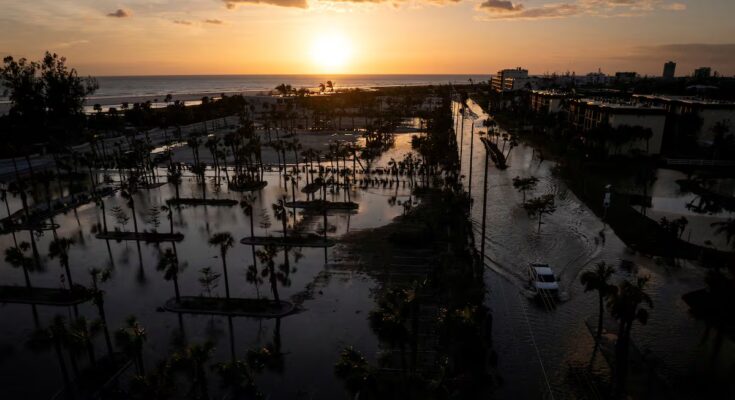In Miami Beach the debate is no longer about whether the climate crisis will arrive, but how to live with it. In this coastal Florida city, where flash flooding has gone from a seasonal phenomenon to an increasingly common nuisance, climate change is experienced as an everyday emergency. A study by the CLEO Institute predicts that by 2100, large areas of Miami could be permanently underwater if sea levels rise by 6 feet, exactly the city’s average elevation.
“If our elevation is above the six-foot level and is expected to rise by the same amount, you don’t have to be a scientist to know that much of Miami will be flooded,” explains Yoca Arditi-Rocha, CEO of the CLEO Institute.
It adds a less visible but equally serious problem: soil porosity. “Sea level rise is seeping into the water table and impacting our water security because the city of Miami’s drinking water comes from the aquifer beneath us, causing it to mix with the salt water in the Miami aquifer.”
Given this diagnosis, it is clear that “climate change is no longer a future threat, but is already underway”. And Miami Beach has decided to take the lead in the fight.
Ground zero for resilience planning
In 2006, long before the climate crisis dominated headlines, Miami Beach created the Environmental Sustainability Committee. At its helm was Michael Góngora, then city commissioner, who recalled that the political and scientific climate was different. “There weren’t many studies on the topic yet, but it was already clear that something had to be done,” he says.
One of the committee’s first conclusions was that the city needed a flood prevention plan. This led to the creation of the Stormwater Master Plan, an ambitious program that included three pillars: raising roads, installing powerful drainage pumps, and building new natural and artificial defenses.
“What we were looking for was to keep the streets dry and healthy,” explains Góngora, describing the mechanism: by raising the level of the streets, the houses are lower to the street, which allows the insertion of underground pumping systems that redirect the water at a higher rate.
Although the project aimed to protect the city from flooding, not all communities welcomed it with the same enthusiasm. In the early years, some of Miami Beach’s wealthier areas vehemently opposed the plan. Góngora recalls that “residents panicked because they couldn’t understand why the city would raise the street while their properties remained underneath,” as many feared that the new elevation would cause more problems than it would solve.
“They were afraid that the water would retreat and cause them to flood,” he explains, though he admits that initial mistrust hindered the project’s progress and forced the city to step up communications to convince residents that water pumps and new infrastructure would prevent precisely this scenario.
Despite neighborhood resistance, the long process of obtaining permits from the State of Florida and legal complexity, work began in 2013 and has expanded since then.
The project also included the construction of retaining walls and the restoration of dunes that serve as the first line of natural defense against rising sea levels.
Over the years, the plan has ceased to be a local experiment and has become an example that other cities across the country are watching closely. The solutions implemented in Miami Beach are now being studied in various parts of the United States as a roadmap for adapting to rising sea levels and increasingly frequent flooding.
“Miami Beach has been at the forefront of resilience planning,” says Alex Fernandez, recently re-elected city commissioner. Note that the Federal Emergency Management Agency (FEMA) has officially recognized the city’s progress, positioning it as a national model.
Although there are no precise figures, municipal authorities recognize that investments in resilience already amount to “hundreds of millions of dollars”, an unprecedented effort whose political impact, admits Góngora, is limited: “It is difficult to promote projects whose results are not seen in the short term and which do not bring votes.”
But the climate emergency, he warns, “does not wait for electoral cycles”.
Climate gentrification
While Miami Beach invests to combat sea level rise, another wave is silently advancing: that of climate change.
In South Florida, historically low-income areas – such as Allapattah, Little Haiti and Brownsville – are paradoxically located on higher ground, making them less susceptible to flooding. This geographic advantage has become a magnet for developers and wealthier new residents.
Expensive insurance is a central part of the problem. Between 2019 and 2024, homeowners insurance rates in Florida increased 55%, one of the most dramatic increases in the country. And, according to data from the Consumers Federation of America, 14% of Latino homeowners and 11% of African Americans can’t afford home insurance, compared to 6% of white homeowners.
For many homeowners, the decision is driven by insurance, which, “in some cases, has doubled in value in recent years.” “Many clients have come to me and said, ‘You know what, Esteban? Let’s sell and let someone else pay for it,'” says Esteban Reyes, a real estate specialist.
In this sense, he also warns that the increased cost of insurance has a direct impact on home purchases: “Depending on how expensive the insurance required by the bank is for that flood zone, this significantly affects the purchase.”
Antonieta Cádiz, executive director of Climate Power in Action, denounces that this is a “very unfair” situation because “millions of people will face what is called climate gentrification: people forced to displace due to the impact of climate change”.
Cadiz estimates that “about half of the 2.6 million residents in the Miami area will face climate gentrification in the near future.”
The cycle is completed when compulsory insurance becomes prohibitively expensive for the population. “Insurance companies realize that disasters continue and do not have enough resources to cover all insured people. So they pass the costs on to consumers,” explains Cádiz. The result? “There are fewer insured people, and in Florida 14% of Latino homeowners don’t have home insurance. If they face a climate disaster, they lose everything.”
The Brownsville case
Between 2010 and 2020, the Hispanic and white population in Brownsville increased by 91.4%, while the African American population decreased by 23.8%, according to census data. In this historically black neighborhood, developers saw an opportunity: elevated land, central location, proximity to trendy areas and still relatively affordable prices.
“Miami’s innermost areas are becoming much more expensive, which means longtime residents can no longer afford to live there,” explains Cádiz.
Thus, the communities that have occupied these neighborhoods for decades are being displaced by higher-income residents, attracted by the relative safety from flooding and lower insurance premiums. Cádiz sums it all up crudely: “They are literally expelled because they see people with more money buying up those areas.”
Experts agree that Florida faces a historic dilemma. On the one hand, cities like Miami Beach are investing billions in adaptation projects, but on the other, climate organizations warn that adaptation alone is not enough without implementing deep mitigation measures to reduce emissions and slow the pace of global warming.
Arditi-Rocha insists that cities must balance both strategies. “Vulnerability exists and is getting worse,” he notes. And scientific projections, including those of American scientistwhich estimates that more than half of the area’s residents could face pressure to relocate if sea levels rise 40 inches – suggest the challenge is only just beginning.
Whether or not South Florida succeeds in becoming a model of resilience will depend, in large part, on its ability not only to defend itself from water, but also to prevent its most vulnerable residents from being left out of the equation.
Because, as organizations and experts warn, the climate challenge is not only measured in millions invested, but also in the ability of a city to protect its inhabitants.
Sign up to our weekly newsletter to get more English-language news coverage from EL PAÍS USA Edition



